The intricate web of digital collectives /P.14 GOOD NEWS
Improv theatre: for the love of risk taking /P.18

A NEW WAY OF TALKING BUSINESS NICE TO MEET YOU
Laura di Muzio, former international rugby sevens and rugby union player, President of Stade Villeneuve Lille Métropole and consultant for France Télévisions /P.22
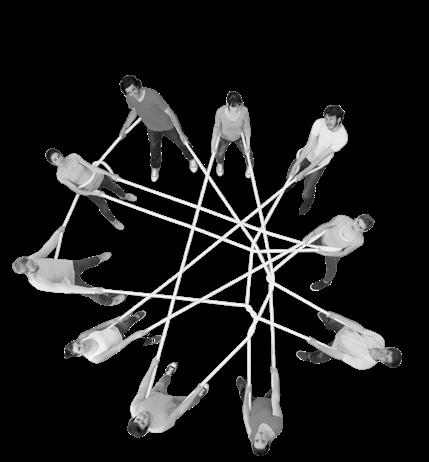
EMPOWERING CHANGEMAKERS FOR A BETTER SOCIETY
09 MARCH 2024
BUSINESS AND RESEARCH
P.04
A BETTER SOCIETY THE COLLECTIVE, WHO ARE WE?
THEY CONTRIBUTED TO THIS ISSUE
… THANKS TO:
• Matthieu Barlet
• Valérie Bertrand
• Mamta Bhatt
• Bernard Coulaty
• Laura di Muzio
• Laurent Dubois
• Grégoire Hugel
• Jorge Jacob
• Laurence Kaufmann
• Bernadett Koles
• Jérôme Moreau
• Frédéric Panni
• Cyril Saunier
A BETTER SOCIETY
Forging the collective: not an easy challenge /P.11

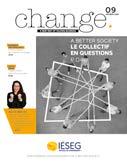
NUMBER 09
The magazine that looks at business in a different way.
IÉSEG
3 rue de la Digue - 59000 Lille 1 parvis de La Défense - 92044 Paris www.ieseg.fr
March 2024
Publishing director: Caroline Roussel
Chief editor: Laure Quedillac
Editorial board: Alexandra Briot, Antoine Decouvelaere, Laetitia Dugrain-Noël, Manon Duhem, Andrew Miller, Victoire Salmon, Vincent Schiltz, Laure Quedillac
Design: alcalie.fr
Editing: alcalie.fr
Photo credits: FESPA France, Georges Fessy (2003 ©Familistère de Guise), IÉSEG, ©Félix Imhof UNIL, iStock2024, Ligue majeure d’improvisation, Sylvain Navaux (2023 ©Familistère de Guise), Xavier Renoux (2016 ©Familistère de Guise)
A BETTER SOCIETY
The Familistère de Guise, an extraordinary collective experience /P.12

GOOD NEWS
GOOD NEWS
Victims: a collective taboo /P.20

Training: the challenge of climbing the ladder /P.21
“Our educational project is based on three pillars: knowledge, know-how and interpersonal skills. Each of these pillars is inseparable from the desire to play as a team.”

Caroline ROUSSEL IÉSEG’s Dean
THE COLLECTIVE, A QUESTION OF TIME
How do you develop a taste for teamwork, and when? You might think that everything is decided when a young graduate joins us in the first year or when an experienced professional joins one of our Executive programs. After all, we are exposed to the gaze of others from a very early age, and socialization is a long process that begins in nursery school. From childhood, human beings learn to become social animals. However, to believe that a sense of community is innate - or that it is acquired once and for all after a certain age - would, in our view, be a mistake, and one that is all the more serious given that the world has perhaps never been as uncertain as it is today. In such a fast-moving environment, lines move, and so do identities and communities. Bringing individuals together in the same place or within the same structure is clearly no longer enough in order to believe that a group can magically become a team. There is always strength in numbers, but the number of variables that threaten the coherence of our groups is such that preserving this precious asset requires constant effort. This is as true in the private domain as it is in the public or professional sphere.
What can IÉSEG do on its own? Make an impact. How can we do this? By learning, by example and by constant practice. Our educational project is based on three pillars: knowledge, know-how and interpersonal skills. Each of these pillars is inseparable from the desire to play as a team. At the school, we don’t just focus on a body of knowledge or skills. We learn how to interact within a team - to ensure that the whole is more than the sum of its parts, to quote Aristotle. This dimension cannot be decreed and is difficult to teach, but it can be experienced and lived every day in our classes, in our projects, in our corridors and within our associations. The diversity of our teams obviously supports this approach. A unique feature of the School, this heterogeneity permeates our courses, our programmes and the way we support our studentsfrom the young graduates who begin their adult lives with us to the more seasoned executives who come to enrich their lives here.
What sets IÉSEG apart is its constant emphasis on teamwork. It encourages exchange, and every exchange is a dialogue, a dialectic that enables us to move forward. As old as philosophy, this constant questioning of the best way to articulate the «I» and the «we» is part of our very identity.
02 N°09 I A new way of talking business 03 A new way of talking business I N°09 LOOK BETWEEN US

From the world of sport to that of politics and activism, the term «collective» has taken hold everywhere, including in the workplace. There, the idea of a work collective is the focus of much attention: how to create it, how to maintain it, how to use it to encourage commitment or performance... But what exactly is a collective? What distinguishes a collective from a team, a group or a community? Laurence Kaufmann, PhD in social sciences and professor at the University of Lausanne, gives us a definition and some insights.
AS A SOCIOLOGIST, HOW WOULD YOU DEFINE THE COLLECTIVE, A NOUN AND AN ADJECTIVE WHOSE BOUNDARIES SEEM BLURRED?
The word only began to take hold in the world of social sciences after 2010, where, until then we had only spoken of society or community. But the term society refers to loose or ephemeral ties, whereas the term community implies particularly strong relationships, for example in the case of a religious community. The notion of collective does not prejudge the nature of the relationships that link individuals together: it leaves open the question of how they are grouped together. Studying a collective means taking an interest in the ways in which a group of ‘I’s manage to form a ‘we’.
WHEN DOES A GROUP OF INDIVIDUALS BECOME A COLLECTIVE?
Let’s take the case of a literary circle that chooses to meet at regular intervals to discuss Shakespeare and decides after lengthy discussions that his best play is Hamlet. Even if they are not necessarily personally convinced, each member of the circle will defend this official position. The collective formed by the literary circle thinks and acts in its own name.
In the same way, when a football team plays a match, each player is in some way accountable for the collective result, even if he doesn’t score.
DOES A NEW MEMBER AUTOMATICALLY BECOME PART OF A COLLECTIVE, OR DOES THIS REQUIRE ANOTHER FORM OF MEMBERSHIP, A SPECIFIC COMMITMENT?
An individual can belong to a collective on paper without being a member in the strict sense of the term, at least as long as he or she does not think in terms of we and as long as he or she does not commit to it in any significant way. This transition from «I» to «we» can be relatively loose. The denser the links, the more the gap between the «I» and the «we» becomes blurred or disappears, and the closer the collective becomes to the community.
ARE THERE ANY SPONTANEOUS OR INFORMAL GROUPS?
THERE’S AN OLD SAYING THAT THERE’S STRENGTH IN NUMBERS. IS THAT WHY A COLLECTIVE EXISTS?
Yes, but this vision coexists with the opposite idea, which is that the collective can slow us down. This is particularly clear in the current school debate: ability groups are based on the idea that one group of students holds back the others. There is a permanent tension between this idea and the opposite one, which sees the complementarity of skills as a way of making us stronger.
WHAT ROLE DO INDIVIDUAL SKILLS, TALENT OR INITIATIVE PLAY IN A TEAM?
The collective starts very early and at a very small level. A classic example is when two people who don’t know each other very well decide to walk together. The simple fact of following in each other’s footsteps creates a kind of tacit system of rights and obligations. Walking with someone means agreeing to wait for them if they need to tie their shoelace or remove a pebble from their shoe. It’s a kind of primitive scene of the collective: by adjusting our behaviour to the other, we create a micro-us. The power of this we is obviously much greater in more complex situations.
“When a football team plays a match, each player is in some way accountable for the collective result, even if he doesn’t score.”
It all depends on the form the collective takes. Some are intelligent enough to tolerate the forces that emerge from below, contributing and proposing, while others get bogged down in hierarchical processes that prevent any form of initiative. It’s all a question of balance: groups that aim to be «headless» or egoless, such as the Gilets Jaunes or Anonymous, quickly find themselves faced with real decision-making problems. Too much horizontality is no more viable than too much verticality. The collective is not the enemy of hierarchy or authority, provided that authority is not based on a simple
05 A new way of talking business I N°09
argument of authority but on skills or solid foundations. The worst form of authority is the arbitrary.
ARE THERE LIMITS OR DANGERS TO EXCESSIVE IDENTIFICATION WITH THE COLLECTIVE?
It can happen that the «I» gives way to a «we» that ends up taking up all the space, at the risk of leading to sectarian or political radicalisation... In a totalising process, there is no longer any room for the individual to distance himself, and who can only think of himself through the collective - a collective that is united by the figure of the enemy and the opposition between «us» and «them».
WHAT ARE THE ROOTS OF A COLLECTIVE? WHAT MAKES IT LAST?
The ones that endure are those that are not content with a formal or abstract display, but who forge deeper links. To stay together, you have to owe something to each other. It’s not just about interdependence or caring. Belonging fully to a collective means feeling obliged to one another.

“The collective is not the enemy of hierarchy or authority, provided that the latter is not based on a simple argument of authority but on skills or solid foundations.”
“THIRD WAVE”: WHEN THE COLLECTIVE GETS CARRIED AWAY
Adapted for the cinema in 2008 («Die Welle» by Denis Gansel), the experiment conducted at Cubberley High School in Palo Alto by Ron Jones remains emblematic. In 1967, this young history teacher with a degree from Stanford faced a challenge: how to teach the mechanics of Nazism to young Californians? Ron Jones relied on roleplaying. He suggested that the class create its own movement, ‘Third Wave’, with its own rules and ‘uniform’. Planned as a one-day experiment, it lasted four days, during which Ron Jones set out four slogans: «Strength through discipline», «Strength through community», «Strength through action» and «Strength through pride». Each pupil was given a membership «card» and randomly selected pupils were given the task of reporting those who did not respect the group’s rules. But within five days, the experiment was spiralling out of control. 200 students joined the Wave, lists of those who didn’t want to join circulated and harassment began to appear. When a brawl broke out during a match, Ron Jones put an end to the experiment with a conference that was supposed to introduce the group to a national leader who didn’t exist. Trapped, the students realise that they have been manipulated. Ron Jones’ isolated experiment is not part of a research programme, has never been replicated and has not given rise to any scientific publication. It is not, therefore, a scientific experiment, but a simple testimonial. However, it raises crucial questions about how easy it is to draw a group into the service of hate speech.


LAURENCE KAUFMANN AND DANNY TROM (EDS.), QU’ESTCE QU’UN COLLECTIF? DU COMMUN À LA POLITIQUE, ÉDITIONS DE L’EHESS, 2010.
THE COLLECTIVE AND THE CHALLENGE OF DIVERSITY
A collective organisation par excellence, the company is made up of men and women who have to learn to work together. And when it comes to innovating, tackling an issue in a different way or breaking with established reflexes, being able to rely on a diverse range of profiles is an undeniable advantage. But how do you go about it? How do you create a working group and get the best out of it when you bring together people with different profiles? Mamta Bhatt, professor of Human Resources Management programme at IÉSEG, explains.

In France more than anywhere else, the business world faces a recurring accusation linked to its alleged lack of diversity, an «entre-soi» which, according to the most critical, veers towards endogamy. Identical profiles, similar educational backgrounds, equivalent career paths... To be honest, this criticism is not confined to business: the world of politics and the media regularly faces the same reproach, and pop culture has long been poking fun at companies where everyone is a carbon copy of their neighbour.
THE DIFFICULTY OF PLURAL AGREEMENT
The cliché has long since been dispelled, however, and diversity has long been a feature of the world of work. But
what does it achieve? We know that diversity facilitates innovation, creativity and decision-making,» stresses Mamta Bhatt. A team with heterogeneous profiles can analyze an issue from different angles, and companies with diverse profiles are better placed to understand the needs of a varied customer base.» Not to mention that this strategy helps to attract the best people: «More and more people want to work in companies that support diversity and offer an inclusive environment for their employees.» But there’s no point kidding ourselves: human nature dictates that diversity in a group is not always self-evident. Prejudice, discrimination and communication problems don’t just magically disappear. Consciously or unconsciously, everyone
Mamta BHATT, professor of the Human Resources Management program at IÉSEG.
Laurence KAUFMANN, PHD/doctorate in social sciences and professor at the University of Lausanne.
FIND OUT MORE ABOUT THIS EXPERT’S ANALYSIS, PERSPECTIVES AND RESEARCH ON IÉSEG INSIGHTS:
06 N°09 I A new way of talking business 07 A new way of talking business I N°09 A BETTER SOCIETY

tends to favour the members of their own group and ignore the opinions of those who are different from them. «To reap the full benefits of diversity, it is important to build an inclusive environment and to work at it,» explains Mamta Bhatt.
INCLUSIVE ENVIRONMENTS, A USER’S GUIDE
To achieve this, the size of the company is necessarily decisive, notes Mamta Bhatt. «Given the resources at their disposal, large groups can more easily deploy structured and explicit policies in favour of diversity. On the other hand, their bureaucratic structures can slow down implementation. Small companies have limited resources but can be more adaptable and work faster. Whatever the profile of the company, building a collective that is both diverse and healthy depends on the will of the director and his or her managers, explains the researcher. «The success of an eclectic team depends on how the unique strengths of each individual are exploited. One way of doing this is to encourage open communication
that allows everyone to share their views. Another is to create opportunities to facilitate contact, for example through shared objectives, ice-breakers or cross-training that allows each member to benefit from the expertise of others. But it’s the whole working environment in the broadest sense that needs to encourage respect for differences.»
FIGHTING AGAINST YOUR OWN IMPULSES
This is no simple matter: «to manage a diverse workforce, managers need to develop the necessary cultural skills, which means recognizing their prejudices and working to remedy them». This is made even more difficult by the fact that everyone is a victim of their own stereotypes and blind spots: «Some aspects of diversity, such as sexual and ethnic differences, have received more attention than others, and organizations have already taken steps in this direction. On the other hand, other aspects such as disability or cognitive condition have received less attention. Companies
are only just beginning to realize that people with neurodiversity have unique skills that can enable greater productivity and innovation. Raising awareness among managers can help, as can fostering a climate of listening and open, safe communication within the team. Regular interviews with team members can help to understand how they are feeling and whether they have any concerns. Experience plays a role, as does training, but nothing is achieved without commitment: «Research suggests that, in general, compulsory training is not as effective as voluntary training,» says Mamta Bhatt.
BREAKING DOWN POCKETS OF RESISTANCE
The challenge remains to be met in sectors that are traditionally very gendered, such as healthcare, construction and public works, engineering… “Several measures could be taken to ensure that these sectors gradually diverge by tackling the structural problems that hinder diversity, as well as the day-to-day problems of interaction. A key step is to introduce inclusive hiring practices such as blind CV selection, diverse interview panels or inclusive language in job descriptions,» explains Mamta Bhatt. However, she warns: «Any effort to change the status quo may be met with resistance, as members of the organisation tend to see efforts to promote diversity and inclusion as unnecessary.» Especially as under-represented groups may not find many people like themselves in their daily lives, and therefore may not flourish at work. There is still a long way to go.
EURATECHNOLOGIES : CREATING STRENGTH FROM DIFFERENCES
Founded in 2009 in the buildings of a former Lille spinning mill, EuraTechnologies is Europe’s largest start-up incubator, with 145,000 m² of premises. More than just a juxtaposition of talents, the accelerator has a particular approach, based on meeting and exchanging ideas. How do you build a team on this campus of young start-ups with very different ambitions and profiles? Matthieu Barlet, Director of Programs, France and Director of the Blanchemaille site, answers these questions.
 Matthieu BARLET, director of programs, France and director of the Blanchemaille site.
Matthieu BARLET, director of programs, France and director of the Blanchemaille site.
WHAT CAN THE COLLECTIVE DO FOR ENTREPRENEURS WHO REPRESENT DIVERSITY?
The first difficulty faced by a business start-up is loneliness. EuraTechnologies was founded fifteen years ago precisely to break down this isolation by bringing together the resources and skills needed in a single location. It’s no coincidence that EuraTechnologies was set up in the Hauts-de-France region, which has a long and powerful tradition of entrepreneurship, from textiles to industry and retail. Of course, there’s no magic formula, but one thing is certain: the first role of an incubator is to open up the various initiatives. It also means giving ourselves the means to reflect together on the culture of entrepreneurship at its most pragmatic. We do this collectively, by pooling the experience of all our
incubatees. It’s by measuring ourselves against the group that we can really put an initiative or an idea to the test, and help a project to mature. It’s by testing your model, product or service and seeing how others perceive it that you can refine your vision. By working together, you can focus properly, open your eyes and benefit from the experience and perspective of others, especially ‘old hands’. Ecosystem partners also contribute their expertise through mentoring.
HOW CAN WE CREATE THE CONDITIONS FOR THIS OSMOSIS BETWEEN THE DIFFERENT
PROJECT LEADERS?
Beyond the purely pedagogical aspects, the location itself has a major influence on the emergence of a collective. Those who come to our sites, every day in Lille, Roubaix, Willems, Saint-Quentin or the Hauts-de-France cyber campus in Lille Métropole, rather than staying at home, do so, of course, in order to find a range of tools and services, but also for the pleasure of belonging to a friendly and pleasant place. Growing a business is not easy. Bringing together people who are going through the same ordeals creates a palpable sense of solidarity and mutual support. Through the activities, events and entertainment on offer, everyone can appreciate the benefits of returning to an ecosystem that gives back everything it’s been given. Everyone can contribute something to others, and vice versa, depending on their skills or experience, and everyone in turn reaps the benefits.
HOW DO YOU MEASURE THE IMPACT OF THE INITIATIVES PUT IN PLACE TO FOSTER THIS SENSE OF BELONGING TO A GROUP?
It’s no coincidence that the vast majority of entrepreneurs who go through our incubation programs ask to keep their premises on site afterwards. Most of the companies we support only leave due to logistical reasons or when required by their growth and commercial policies. Another key indicator is their involvement when we ask them to sit on selection panels for new incubatees. They are also on hand to help entrepreneurs who are going through difficulties of all kinds, including personal ones. But the best proof of their attachment to EuraTechnologies is that they very often become our first ambassadors in the outside world, sometimes years after passing through IÉSEG.

EURATECHNOLOGIES SUPPORTS AROUND
200
NEW ENTREPRENEURS EACH YEAR IN ITS VARIOUS PROGRAMS.
08 N°09 I A new way of talking business 09 A new way of talking business I N°09
A BETTER SOCIETY
MANAGING DIFFERENCES FORGING A TEAM: NO EASY TASK
While not everything is perfect when it comes to diversity, workgroups are becoming increasingly international and heterogeneous. To get the best out of them, there are two major opposing views, explains Jorge Jacob, Professor of Marketing at IÉSEG.
DIVERSITY IS ON THE INCREASE WITHIN THE COMPANY.
HOW CAN WE MAKE THE MOST OF THIS PLURALITY?
There is no one-size-fits-all approach to harnessing the diversity of a team within a company, as the use of this plurality is influenced by ideologies and belief systems which guide the way in which individuals perceive and approach cultural and ethnic groups in a given context. Two main approaches can be distinguished which value diversity in different ways: a ‘colour-blind’* vision which minimises differences and emphasises commonalities, and a multicultural vision which favours a mosaic of cultures. Each company can adopt the path that corresponds to its values, its organisational culture, the nature of its workforce, the sector in which it operates...
FRANCE TENDS TO TAKE THE FIRST ROUTE. WHY IS THIS?
Since the French Revolution, France has encouraged the emergence of a culture of assimilation based on universal values that take precedence over individual origins. Public discourse in France deliberately plays down cultural, religious or ethnic differences, which are relegated to the private sphere in order to promote a sense of equality and unity within the country. This vision has both advantages and disadvantages. In principle, this vision defends the idea that all potential differences between groups should be avoided in order to reduce tensions. However, research reveals some potential drawbacks, as this approach paradoxically leads to an undesirable increase in discrimination and prejudice. Unwittingly, proponents of a colour-blind approach may be perpetuating ethnocentrism by expecting others to conform to the norms of their community.
DO OTHER COUNTRIES APPROACH THE ISSUE DIFFERENTLY?
The multicultural approach considers that culture and ethnicity are at the heart of an individual’s identity. It protects minority cultures from the pressures of assimilation by emphasising the importance of cultural differences. Multiculturalism makes it possible to look at diversity from a different angle by emphasising differences and seeing them as potential strengths.
DOESN’T THIS RUN THE RISK OF HAMPERING COLLECTIVE’S EXPRESSION?
A large body of research shows that members of non-dominant groups often prefer multiculturalism in organisations because it corresponds to their needs and their desire for recognition. Exploiting this diversity can lead to positive outcomes such as innovation, inclusion and a better understanding of the needs of different consumers, but it does introduce complexity. But it can also unintentionally lead to undesirable effects. It can make their difference from others more visible to members of non-dominant groups. Moreover, for members of dominant groups, multiculturalism can foster a feeling of exclusion and therefore trigger threats between groups. It is essential to find the right balance to maximise the benefits of multiculturalism without complicating collective expression.
*Literally “colorblind”

The collective, yes, but what are we talking about? How do we define it, how do we create it and how do we maintain it? Bernard Coulaty, former HR Director (Danone, Pernod Ricard) and Academic Director of IÉSEG’s Executive Specialized Masters in Management Transformation and Human Development.
WHAT IS A COLLECTIVE?
FIND OUT MORE ABOUT THIS EXPERT’S ANALYSIS, PERSPECTIVES AND RESEARCH ON IÉSEG INSIGHTS:
“Public discourse in France deliberately plays down cultural, religious or ethnic differences, relegating them to the private sphere to promote a sense of equality and unity in the country.”
What makes a group of people become a collective? «Obviously, it’s not enough to get people to work together and magically create a collective,» points out Bernard Coulaty. In sport, as in business, a team is defined by the ability of its members to trust each other in order to achieve a common goal, in this case, an economic one, in the professional world». The differences are minimal, except for one detail: «In a company, there are several groups: the executive committee, the managers, the employees in each department, etc. The specificity of the professional world lies in this additional difficulty: getting this meta-group to work together and ensuring that everyone plays the game without pursuing their own strategy.
WHAT MAKES ONE GROUP MORE EFFECTIVE THAN ANOTHER?
The more competitive an economic sector, the more effective the team has to be to succeed against the competition. How can we oil the machine to make it perform better? «In a world as volatile as ours, agility, solidarity, the ability to innovate and creativity make all the difference, without ever losing sight of the notion of well-being. The art of the manager is to ensure that the collective is not exposed to harassment or burnout, while fighting against individualism. As Aimé Jacquet once said: «it’s not wearing the same jersey that makes a team, it’s sweating together». In business, we find issues that cross the whole of society», observes Bernard Coulaty.
HOW DO YOU KEEP THE FLAME BURNING?
Departures, recruitments, mergers... A work group is rarely stable. How do you manage the unexpected and integrate new people without upsetting the balance of the team? «It’s the ability to create commitment that makes a good manager. This requires a constant balancing act between two dangers: excessive benevolence and excessive demands. By pushing the cursor too far in one direction or the other, you can endanger the team in two ways. Too much benevolence can undermine performance, and too many challenges can lead to saturation or burnout. To avoid falling from Charybdis into Scylla, «you have to cut off both ends of the omelette», Bernard Coulaty sums up. The best bosses are those who are able to protect their teams while helping them to grow.

REMAINING COLLECTIVE IN A WORLD THAT IS INDIVIDUALISTIC
Teleworking, staff turnover... Professional practices have changed and in the world of work, as elsewhere, the tendency towards individualism sometimes undermines the shared experience. How do we deal with this? «You have to know how to manage, communicate, coach, listen and deal with day-to-day issues... The challenges are such that many employees are no longer interested in these positions, hence the management crisis we are experiencing. The crisis is all the more profound because this is an area where training is not everything. The best advice would be not to rush into appointing a new manager, but to take the time needed to choose the person who has both the temperament and the skills needed to get the best out of his or her team».
FIND OUT MORE ABOUT THIS EXPERT’S ANALYSIS, PERSPECTIVES AND RESEARCH ON IÉSEG INSIGHTS:
Jorge JACOB, marketing professor at IÉSEG.
Bernard COULATY, academic director of IÉSEG’s Executive Specialised Masters in Management Transformation and Human Development.
10 N°09 I A new way of talking business 11 A new way of talking business I N°09 A BETTER SOCIETY

THE FAMILISTÈRE DE GUISE, AN EXTRAORDINARY COLLECTIVE EXPERIENCE
Founded in the 19th century, the Familistère de Guise housed up to 2,000 inhabitants on a site that was part working-class housing estate, part large-scale social experiment. Conceived by Jean-Baptiste Godin, this concrete utopia was based on a blend of idealism and pragmatism, in the service of a collective project summed up in one phrase by its founder: «the pleasure of each one is increased by the pleasure of all». Here’s a look back at a unique experience.

Rome wasn’t built in a day, and neither was the Familistère de Guise. Built gradually, between 1859 and 1884, the site was organised around the factory created by its founder, Jean-Baptiste Godin. In addition to the three wings housing the Palais Social, community facilities were added: a nursery, schools, a theatre, a commissary, a pleasure garden, a library, a laundry and a swimming pool... A city in its own right, with its own housing, community services and social organisation, the Familistère was built on a foundation that was both utopic and pragmatic, explains its director, heritage curator Frédéric Panni: «Even though he examined it through the sieve of his own convictions and experience, Godin was undoubtedly part of the prevailing thought of Charles Fourier and those whom Marx described as utopian socialists. But Godin did not see himself as a utopian. In founding the
social, economic or intellectual. In his view, there was only one way of achieving this: by combining capital and labour, and ensuring that the latter governed the former. Entrepreneurial and gifted, Godin made his fortune by establishing himself in the rapidly expanding market for heating stoves. The industrialist then had the resources needed to finance the first social experiments, such as the phalanstery founded by Victor Considérant in Texas. The experiment was a failure and Godin lost a third of his fortune, but drew lessons from it that would enable the Familistère to see the light of day.
LET US ALL BENEFIT FROM EACH OTHER
LEARNING TO WORK TOGETHER
Familistère, he was taking a social science approach. Just as Newton had formulated certain fundamental laws of physics, it was a matter of understanding the rules that govern life in society in order to move towards a form of collective harmony that would enable the most disadvantaged to emancipate themselves».
PUTTING WEALTH TO WORK
This sensitivity to the plight of the most humble can probably be explained by his own origins. The son of a factory worker and trained as a locksmith, Godin left his village in Thiérache at the age of 15 undertaking a tour of France that enabled him to become aware of the living conditions of the working class at the time of the first Industrial Revolution. Frédéric Panni explains: «He believed that those who produced wealth had the right to a form of collective emancipation, whether
Taking action, Godin drew on his industrial expertise. A born organiser, he designed a project financed entirely by industrial profits. Frédéric Panni insists: «His undertaking had only one aim: to generate wealth that would benefit workers, first in the form of a social institution, then collective housing and finally an economic system with the creation of the Société du Familistère, a production cooperative, in 1880». Without ever forgetting collective protection: social protection, accident insurance, a pension fund... At the heart of the 19th century, the Familistère experiment was visionary and far ahead of its time. Godin adopted a pragmatic approach to creating his collective project. «The Familistère was built without an architect, with Godin as the project manager, and its overall plan had the distinctive feature of being able to be realised progressively. In his eyes, everything was based on the individual freedom of each person: no one was obliged to live at the Familistère in order to work in the factory». Little by little, however, the Familistère grew up around three apartment blocks - the Palais Social - built a stone’s throw from the factory around vast covered courtyards. The flats had several rooms and were heated. Schools are co-educational and compulsory up to the age of 14. Le Familistère was self-managed, with everyone a co-owner. Designed in line with the hygienist and modernist convictions of its founder, the place reflects the notion that the collective makes it possible to create «equivalents of wealth». Although the workers could not access it individually, they benefited from it by sharing it collectively. «The services that the rich derive from domesticity are replaced by common institutions», wrote Godin.
This sense of commonality was not a matter of course, explains Frédéric Panni: «Godin did not believe in the spontaneity of a harmonious social organization that would magically appear. His city was not an end in itself, but simply the ideal environment in which to achieve social transformation, a collective dwelling designed so that a community could flourish. The Familistère thus became a place of learning for a process of collective emancipation. «Godin created all sorts of self-managed structures with elected officials: a festival committee, another for health insurance, another for the pharmacy, etc. The residents learned about social democracy there, and he saw himself as a sort of controller of a slow process. The industrialist gives lectures at the theatre to teach his employees the «benefits of cooperation, participation and collective responsibility». At the same time, he is constantly reiterating what an experience of social democracy entails: «listening to others, learning to express yourself so that you are understood by others, knowing how to defend your arguments...».
A UNIQUE EXPERIENCE
For the rest, Godin believed in the virtues of dialogue to bring about a real fraternity between the Familistère’s inhabitants. The passageways leading to the flats provided opportunities for workers to
meet, whatever their position in the factory hierarchy - labourers, office workers or managers. Interior windows and communal living in an airy but enclosed space also encourage emulation: a well-kept interior should encourage everyone to look after their own home, with the other person’s gaze - and potential disapproval - being both a driving force and a motivation.
A REMARKABLY LONG LIFE
Although the association founded by Godin was dissolved in 1968, it continued to operate for another 80 years after his death in 1888 - a remarkable longevity that begs the question: why hasn’t the Familistère experiment been replicated elsewhere? «The Familistère was partly based on the success of the Godin factory*, but also because this collective experimentation was initiated by a man whose thoughts ran through the whole project. The Familistère is an undeniable success, with 2,000 people involved, but it has not spread. This raises the question of the very nature of the Familistère: if it’s an experiment, why can’t it be replicated? However admirable it may be, the question of the Familistère’s success owes everything to its founder - however paradoxical that may be for a collective experiment.
*Now under control of the Les Cheminées Philippe group.
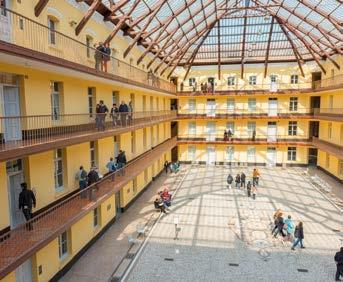
12 N°09 I A new way of talking business 13 A new way of talking business I N°09 A BETTER SOCIETY
Frédéric PANNI, heritage curator of the Familistère.

THE COMPLEX WEB OF DIGITAL COLLECTIVES
Only yesterday, the concept of online communities would have made sceptics smile, unconvinced by the solidity of the links forged back in the days of forums and IRC channels (remember ICQ or MSN Messenger?). Social networking has come a long way since then, and nowadays nobody really distinguishes between the links forged on the Web and those forged by ‘IRL’. But are they the same thing? What are the specific characteristics of these collectives and those of our immaterial doubles that they constitute? Answers from Bernadett Koles, a lecturer at IÉSEG and a specialist in online communities.
Virtual worlds, social media, online games... After years spent exploring the intricacies of digital communities, Bernadett Koles has more recently turned her attention to the groups that form around certain content creators: bloggers, Youtubers, streamers, Instagram figures and so on. Why do these web figures attract so much attention? «Film stars, football players, music groups and other celebrities have always been able to attract fans, but the emergence of social media has enabled them to extend their presence to online spaces», explains Bernadett Koles. With serious advantages such as the removal of geographical and spa-
tial constraints or the ability to address their fans more often in frequently creative and innovative ways. But even more interestingly, «other virtual communities have formed around previously unknown people, in a more organic and autonomous way. Platforms have enabled ‘ordinary’ people to make a name for themselves and attract an audience around their passions,» says Bernadett Koles. I’m particularly interested in these communities insofar as they have a real influence on the trajectory of the person who joins them.


A SENSE OF BELONGING
It remains to be seen what differentiates these vast virtual collectives from offline communities. «They share a number of characteristics, but differ in other ways. In particular, platforms allow greater interactivity, whether with the celebrities they follow or with other members of the public or ‘fan club’, because it’s very easy to like, follow and comment on messages from other members of the community.» But that’s not all: «digital allows fans to engage asynchronously, for example by interacting with the social accounts of a particular actor or singer, but also synchronously, for example by taking part in a live event» - this is one of the principles of streaming.
NETWORK STARS
Forget TV presenters: these days, the personalities with the biggest following on the networks bring together communities and achieve audiences that would make Nagui or Karine Le Marchand pale in comparison. In France, the most popular influencers are Youtubers McFly & Carlito, who have 7.5 million subscribers, well ahead of Lena Situations, who is still going strong with 4.2 million followers on Instagram and 2.5 million on YouTube. As for the streamers, it’s no surprise that Squeezie is the winner, with 18 million subscribers on his YouTube channel and a literally overwhelming influence among 15-24 year-olds. And the next generation is arriving with the likes of Léa Elui. Never heard of her? You’ll have to get used to it: at 22, the young star of Tik Tok is the most followed Frenchwoman on social networks, with over 30 million followers.

Bernadett KOLES, professor at IÉSEG and specialist in
607 MILLION FOLLOWERS ON INSTAGRAM, CRISTIANO RONALDO IS THE MOST FOLLOWED PERSON IN THE WORLD ON A SOCIAL NETWORK. WITH
“More immersive, these environments also encourage excitement, curiosity and a sense of belonging. Last but not least, «digital communities give members a form of control that can sometimes turn into co-creation by helping the celebrity’s own digital identity to evolve. This allows for dynamic, reciprocal experiences between the celebrity and their fans, but also between followers”. The researcher insists: «the commitments and relationships forged in these virtual settings are just as real and profound - if not more so - than those in the physical world». Deep, but how deep? How do these groups manage differences of opinion, disagreements and internal conflicts? What brings these communities together is a digital character with
FIND OUT MORE ABOUT THIS EXPERT’S ANALYSIS, PERSPECTIVES AND RESEARCH ON IÉSEG INSIGHTS:
his or her particular interests and expertise,» says Bernadett Koles. This identity must be constant, otherwise the very foundations of the community are in jeopardy. If the community perceives a lack of authenticity or loyalty on the part of the person bringing them together, the fierce competition that reigns in the ecosystem of streamers and influencers is likely to do the rest: fans are spoilt for choice. The level of posts is just as important: many video game streamers follow a strict schedule and many testify that they can’t take holidays or real breaks in order to ensure the continuity needed to maintain their base». Sometimes even violence and harassment can enter this often unforgiving world: «There are cases of bullying that are very damaging to content creators and their communities. This is a frequent complaint from online video game streamers, particularly women, to the point of calling their online presence into question.» Alas, nothing new under the sun on this point.
digital communities.
14 N°09 I A new way of talking business 15 A new way of talking business I N°09 BUSINESS AND RESEARCH

AGRICULTURE IN THE VOSGES
In 2018, four farms in the Vosges region joined forces to install the first methanation unit in their locality. The aim is to supply local residents with clean energy, recycle organic waste and help reduce greenhouse gas emissions. A collective challenge that requires constant effort.
ARE FRANCE’S AGRICULTURAL COOPERATIVES IN DANGER OF RUNNING OUT OF STEAM?
The principle of the cooperative economy has won over an agricultural sector that is extremely sensitive to the values of support and mutual aid, accounting for 40% of France’s agro-industrial sector. While the 2,200 cooperatives in France include a number of giants (InVivo, Tereos, Agrial, etc.), the bulk of the cooperative network is still made up of very small businesses and SMEs. However, this idea of collective commitment is facing a new kind of crisis: according to the Observatoire de la gouvernance des coopératives agricoles, 75% of cooperatives are facing a decline in member commitment, with fewer and fewer members taking part in bodies where their votes carry equal weight. This is undoubtedly the consequence of the massive consolidation that has been underway for the past ten years: marked by a 25% decline in the number of cooperatives, this trend has also resulted in a move away from decision-making centres. There is a risk that a vicious circle will be set in motion: frustrated at feeling less represented, some farmers risk becoming even more disengaged, becoming phantom members.
strong choice: «Our farms are not all the same size, and not all farms are able to inject the same quantities of waste, but we wanted everyone to contribute equal capital. It’s a way of ensuring that we all feel equally involved», explains Cyril Saunier. This equality in the amounts invested is matched by appropriate governance: «the rules stipulate that major decisions are taken unanimously». Day-to-day management, too, is based on a fair balance of tasks, with an on-call system. «Managing the plant represents the equivalent of one and a half FTEs over the year. On each farm, a partner is appointed to make the necessary time available. Three of us look after the technical side and another partner looks after the admi-
nistrative side. Everyone keeps a record of their hours so that everyone is on the same page.
COMMON GROUND
A member of several agricultural cooperatives (see insert), Cyril Saunier didn’t hesitate for a second before embarking upon this collective project: «as soon as you can work together, it’s worth it». But not everything can be taken for granted: «You have to make sure that personal interests don’t outweigh the common interest. When there are eight of you around a table, it’s not easy. In the fist few months consensus wasn’t a problem. Over time, it sometimes becomes more complex because we have to agree
TWO QUESTIONS TO GRÉGOIRE HUGEL
on the strategy to adopt.» Achieving the right balance between individual expectations and the collective interest requires constant adjustments and regular exchanges - once a month, or even once a week. To date, any disagreements have always been resolved without the need for an outside mediator. «We always manage to find common ground,» concludes Cyril Saunier. He is still convinced that there is strength in numbers.
With its large white tarpaulins and rounded buildings, it’s hard to miss the bio-methanation unit that stretches for just over a hectare on the outskirts of Chaumousey, in the Grand Est region of France. Opened in June 2019, the facility supplies 5,000 residents with bio-methane, a green gas produced from the livestock effluent of the four farms that make up SAS Agri GN Vosges, which is fed by the organic waste produced by some 600 cattle.
A COLLECTIVE PROJECT
A small feat for a project that could only have been a collective one, as Cyril Saunier, one of the eight partners involved, recalls: «The gas pipes of the public network run alongside our farms, which opened up prospects for biomethanation. But for reasons of profitability and workload, it was hard to imagine each farmer building his own small unit on his own. The amount of investment required - five million euros - also discourages isolated initiatives. With the support of the Chamber of Agriculture, a collective project was born, with adapted financing solutions through bank loans, but not only: «the public players provided a subsidy of €1.2 million and each of the eight partners invested €50,000». This was a
Managing Director of Mignotgraphie and Olinda, Grégoire Hugel defends the interests of the screen printing sector within FESPA France, an organization that brings together more than 500 visual communications professionals. Competitors who also know how to collectively defend professions under pressure.
WHAT ARE THE GOALS OF FESPA FRANCE?
Beyond the obvious aim of sharing the common passion that brings us together, we are collectively involved in legislative issues. Signs, screen printing, signage, installation... All our businesses are subject to regulatory frameworks that are all the more complex because they are constantly evolving. Some of them threaten our very existence, like the idea of banning illuminated signs. We are fighting to influence the debate and raise awareness among local and nationally elected representatives, encouraging them to look beyond dogmatism and preconceived ideas. Finally, we have a project that aims to overhaul our entire collective agreement, which is now outdated on certain points. Training issues are also being addressed. Some of our professions did not exist until recently, and we would like to see new courses of study and new diplomas recognised.
YOU FORM A COLLECTIVE, BUT YOU ARE ALSO COMPETITORS.
IS THAT A PROBLEM?
We are not competitors but colleagues and often friends. Of course, we sometimes position ourselves on the same markets, but for obvious ethical reasons we never discuss this within FESPA France. This does not
prevent us from showing solidarity: on my initiative, the association helps companies in difficulty by providing them with support, a sympathetic ear and appropriate advice.
# GOING FURTHER
http://www.fespa-france.fr
 Part of the members of FESPA France.
Part of the members of FESPA France.
16 N°09 I A new way of talking business 17 A new way of talking business I N°09 BUSINESS AND RESEARCH
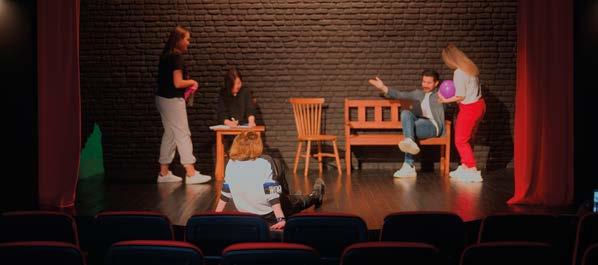
IMPROV THEATRE: FOR THE LOVE OF RISK TAKING
Going on stage without a text, no props, no set and no stage directions: that’s the challenge of improvisation. How do you create something when you have little or nothing to go on? How can you rely on the rest of the troupe to invent a text, a character and a story? How do you ensure that a company succeeds in creating a new, ephemeral and original miracle every night? Laurent Dubois, managing director of the Ligue Majeure d’Improvisation, explains.

Laurent DUBOIS, managing director of la Ligue Majeure d’Improvisation.
IN IMPROV, THE SHOW DOESN’T EXIST UNTIL THE ACTORS ARE ON STAGE. HOW DO YOU PREPARE FOR THIS?
It requires a technical base, codes and a sense of listening that you work on beforehand. Improvisation is the science of the present time. On stage, everyone has to be there in the here and now to respond to the proposal that another actor makes to them, which by definition they don’t know. You have to be fully available to accept whatever comes your way. You can’t refuse what has just been said: the whole room has heard it. Even if that’s not where you wanted to go, you have to
accept it so that you can do something with it and invent the rest of the story and the character. The rest is about letting go. That’s what makes it possible to create a collective moment that lasts just a few minutes, but which holds its own magic. The sincerity of the actors is decisive: if the collective believes in what they are portraying on stage, the audience will follow. In a way, the best compliment an audience can pay us is to come away convinced that everything was written. Even if that’s never the case, it’s a sign that the troupe has found the right chemistry.
WHAT ATTRACTS AN IMPROV COMEDIAN?
You have to be willing to take risks and enjoy the risks involved. In film or classical theatre, you work in precise, meticulous environments. Improvisation is uncharted territory, a universe in which nothing is certain. And that’s the point! At all costs, you have to avoid ease, routine or reflexes, for example the temptation to repeat things, characters or worlds that have worked before. In improvisation, the risk is to make do with very little, especially in front of an unfamiliar audience and with spectators who are relatively easy to impress.
A BRIEF HISTORY OF IMPROV MATCHES
The best-known form of improvisational theatre, improvisational matches were born in 1977 from the imagination of two Quebec actors from Montreal’s Théâtre Expérimental, Robert Gravel and Yvon Leduc. Determined to offer audiences a new experience, they chose to parody the world of ice hockey. All over the world, the form imagined in Montreal has remained, with its ritual and matches between two mixed teams of seven under the authority of a referee charged with enforcing a few golden rules. You never say no to the themes proposed, you never get out of character... The framework varies in terms of the length of the matches, the number of players, the theme proposed, the nature of the mixed or comparative improvisation...
WHAT’S A REHEARSAL LIKE IN AN IMPROV TROUPE?
90% of the time, we’re just improvising! The rest of the time, we draw on a variety of imaginary sources and worlds: films, plays, music... Although it’s not necessarily the same thing, you need to be able to draw on a form of general culture.
ON STAGE, THERE IS NO SET, NO COSTUME, NO PROPS. IS THAT A LIMIT?
Sometimes it’s even worse. In an improvisation match (see insert), you’re dressed in a hockey shirt, which doesn’t really help you to play a knight or an astronaut... The rest of the time, this void is more of an opportunity in that it encourages you to take risks. The audience appreciates it all the more because improvisation also works because you’re always on the edge and the audience is waiting for the moment when you’re going to slip up.
THE NEW YOUTH OF ROLEPLAYING OR THE COMEBACK OF THE COLLECTIVE
Thank you Stranger Things. In the wake of the Netflix series and its many nods to the Dungeons & Dragons (D&D) games of the 1980s, the role-playing game is experiencing a new golden age. Widely played from the 1970s onwards, before giving way to video games, role-playing games are enjoying a comeback. Instead of pitting players against each other, role-playing games are about working together to bring a game to a successful conclusion. Gathered for a collective story improvised in real time, the players must cooperate to progress despite the pitfalls of a scenario that unfolds under the authority of a game master. Role-playing games have been made into series, films and video games, and their success reflects the changing tastes of consumers, who have grown tired of the ultra-competitive atmosphere of classic games.
MISTAKES ARE BOUND TO HAPPEN. HOW CAN YOU COMPENSATE FOR THEM?
In an improv match, this is the referee’s job. When the whistle sounds for a foul, it’s usually to divert the audience’s attention towards himself and protect a comedian in trouble. The rest of the time, no improviser leaves a colleague in trouble - which doesn’t mean that we always manage to save a proposal that has got off to a bad start, but that everyone pitches in to throw a lifeline.
IS IT EASY TO INTEGRATE NEW
MEMBERS
INTO A WELL-OILED
TEAM?
New blood is invaluable for avoiding routine. Bringing in new people is a way of spicing things up and setting yourself new challenges. But it’s not easy: when you start out, you generally make rapid progress, but then you come up against a glass ceiling that only the virtuosos manage to break, at the cost of considerable humility and hard work.
MANY COMPANIES ARE TAKING AN INTEREST IN IMPROVISATION BY INCLUDING IT IN THEIR TRAINING PROGRAM. WHY IS THIS?
The link is obvious insofar as companies today are sailing in uncertain waters, without knowing what tomorrow will bring. The best strategic plan in the world can explode in mid-air at any time, as the pandemic has clearly shown. This unknown is our raw material. We can provide executives and managers with a set of tools that can help them deal with an event that wasn’t in the game plan. Rather than running away from it, fearing it or denying it, we can arm them to get something interesting out of it.
# GOING FURTHER
https://ligue-improvisation.com/


18 N°09 I A new way of talking business 19 A new way of talking business I N°09 GOOD NEWS

A COLLECTIVE TABOO
While on paper French law is one of the most protective for victims of inappropriate or reprehensible behaviour, the professional world is still struggling to get to grips with the subject. How can we combat this poison that threatens the collective? Answers from Jérôme Moreau, Chairman of France Victimes.
No human group is immune to the risk, too often overlooked, of one or more of its members falling victim to another. Sexual harassment, moral harassment... If the world of work is particularly exposed to this, it’s because of the demands of performance and competition are a source of potential circumstances, of control or domination - all barriers that can restrict victims from speaking out. While many remain silent, «the silence is gradually breaking down», says Jérôme Moreau. Not least since #MeToo, but not only: «the very notion of victimisation is evolving, both in society and in the workplace. We have moved on from a strictly criminal notion - which of course remains at the heart of France Victimes’ approach - to a vision of prejudice and trauma that goes beyond the strict framework of breaches of the Criminal Code or the Labour Code.»
THE END OF A TABOO
Although there are still cultural obstacles to overcome, some companies such as L’Oréal and Super U are leading the way in terms of monitoring and prevention, explains Jérôme Moreau: «I have a lot of faith in the impact of the pioneers, just as I believe in the fact that today people are more aware of their rights, and that changes the game». The role of France Victimes is not neutral: present in the 167 judicial tribunals in France, the federation is the only network capable of providing victims with free social, legal and psychological support and protection, whatever their profile. As a training organisation, France Victimes also works upstream with
 Jérôme MOREAU, president of France Victimes.
Jérôme MOREAU, president of France Victimes.
TRAINING: THE CHALLENGE OF CLIMBING THE LADDER
Intricate work, training requires precise adjustments. How do you go about it when you need to quickly train large cohorts?
MMA, MAAF GMF... All these mutuals belong to the Covéa Group, one of the leading players in the French insurance market. With its 21,000 employees and 11.5 million customers and member-policyholders in France, Covéa is regularly faced with training challenges that are often decisive,» explains Valérie Bertrand, internal consultant and project manager at the Covéa Group. In 2019, the Group is facing a huge challenge: training 680 managers to meet the priorities set out in the strategic plan (Covéavenir). There are five words that make up the Covéa acronym: Cooperate, Dare, Value, Commit and Act,» adds Valérie Bertrand. The first sums up one of the Group’s ambitions: to encourage the development of a common culture in a group that brings together brands with very strong identities, each endowed with its own culture. It was therefore necessary to create bridges between the various managerial practices, while at the same time promoting the work of the managers, who are the essential relays of the Group’s ambitions».
BUILDING A COLLECTIVE DURING THE PANDEMIC
• FRANCE VICTIMES FEDERATION BRINGS TOGETHER 130 PROFESSIONAL ASSOCIATIONS SPECIALISING IN VICTIM SUPPORT.
• FREE AND ACCESSIBLE 7 DAYS A WEEK, 116 006 IS THE NATIONAL VICTIM SUPPORT NUMBER.
Developed in 2019-2020, the scheme was completed at the end of 2022 - a longer deadline than anticipated, due to Covid. «Initially, we wanted to kick things off with a major event at a prestigious venue. The pandemic turned everything upside down, but we were able to maintain the principle of a collective event, at a distance, in an original televised format, along the lines of the American Late Shows», continues Valérie Bertrand. The program has been changed, and needs to evolve. With the help of CEGOS and IÉSEG, a project team of twelve people took charge of designing the program, with the support of several in-house experts. The originality of the system lies in the fact that it was tailor-made,» says Valérie Bertrand. Built around eight different sprints, the program included preliminary self-diagnosis tools to help each participant choose the paths best suited to their expectations, the challenges facing their management and the needs of their teams».
INSPIRING APPROACHES
companies and leading schools to help them make progress in terms of detection and prevention. «We always come back to the fundamental rights of individuals: there is no compromise regarding respect, the integrity of the body and dignity. Once this reminder has been given about what is forbidden, everything else unfolds: consent, discrimination on the grounds of disability, origin or age, harassment, etc.» While France Victimes obviously cannot handle everything, this approach is essential: «everything must be done to act before there are victims.»
In addition to the traditional formats, the programme is based on face to face business visits. which have been held face-to-face. Organised in conjunction with IÉSEG, the visits were very well received and encouraged managers to open up to other forms of thinking and approaches, which were unanimously judged to be inspiring. Designed for a shorter period, the initial timetable was obviously stretched because of the pandemic. We had to adapt, but in the end the planets were aligned,» says Valérie Bertrand. We were able to conclude with a major live event, which enabled us to achieve our initial objective of creating a dynamic collective and a common managerial base. The programme encouraged exchanges between the managers of our different brands and enabled them to network, while giving them time to breathe. Satisfaction surveys have shown that the scheme has been particularly well received.
 Valérie BERTRAND, internal consultant and project manager for the Covéa Group.
Valérie BERTRAND, internal consultant and project manager for the Covéa Group.
20 N°09 I A new way of talking business 21 A new way of talking business I N°09 GOOD NEWS
TEAMWORK
Laura di Muzio is a former international rugby sevens and rugby union player and President of Stade Villeneuve Lille Métropole, and has gradually established herself as a familiar voice on public service television. She has been a consultant for seven years, commenting alongside Jean Abeilhou on broadcasts of women’s competitions on various France Télévisions channels. In particular, she followed Les Bleues’ fine run at the last Six Nations tournament, finishing second behind England. For Change, she looks back on a career that has always been about teamwork, both on and off the pitch.
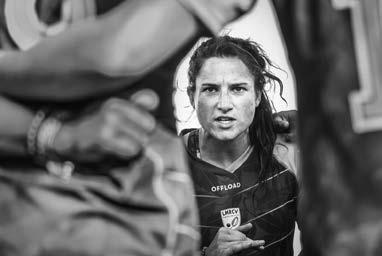
YOU STARTED PLAYING RUGBY AS A TEENAGER. DID YOU ALREADY HAVE A TASTE FOR TEAMWORK?
I didn’t turn towards the oval ball for that reason, since I was already playing a team sport at the time - football, in fact. What attracted me to rugby in particular, was the kindness with which I was welcomed from the very first training sessions. I was rather shy and introverted. felt reassured from the very first session and was immediately adopted by the rugby family.
BY ITS VERY NATURE, RUGBY IS BASED ON THE ADDITION AND COMPLEMENTARITY OF INDIVIDUAL TALENTS. HOW DO YOU RECONCILE THE ROLES OF EACH INDIVIDUAL WITH THE COLLECTIVE ASPECT?
Whatever happens, it’s always the team that comes first. As a player, as a coach and then as President, I’ve always made sure that we stay the course. Each athlete must, of course, progress individually in order to perform and make the most of their abilities, but each one is just one link in a large chain. This is true of
great players, you’re successful because you’re able to maintain an ironclad solidarity within a group.
YOU DISCOVERED A NEW ROLE WHEN YOU BECAME A CONSULTANT A FEW YEARS AGO. HAVE YOU REDISCOVERED THIS COLLECTIVE DIMENSION?
WOMEN’S SPORT, SIXTEEN TIMES LESS VISIBILITY THAN MEN’S SPORT
all team sports, but rugby embodies it in a particularly pronounced way. Its rules and its very essence mean that only the collective can succeed. You can have the best player in the world in your team, but she won’t achieve anything on her own. In basketball, football or handball, it’s easier to achieve individual success by serving the forwards who remain at the front. In rugby, the ball can only be kicked backwards, which means that you literally cannot move forward and score without the support of your team-mates. Everyone supports the person carrying the ball. No one is isolated, but the individual is nothing without the group.
YOU’VE BEEN A PLAYER, CAPTAIN, COACH... IS THE MESSAGE ALWAYS THE SAME IN THESE DIFFERENT POSITIONS OR DO YOU HAVE TO EMBODY IT DIFFERENTLY EACH TIME?
The tone and the words change, but the common thread never varies. If the instructors at one or other of the small clubs say exactly the same basic things as those in the upper echelons of the national authorities, it’s because that’s the only way to perform. You get used to it from a very young age, for example by collecting your equipment together after training. Don’t leave a friend alone on the bus, don’t lose your temper with a team-mate, don’t reproach her when she drops the ball... These are principles that you learn very early on, but that you carry with you throughout your life, at every level. The strength of a good coach is knowing how to put together a cohesive group. You’re not successful just because you have
When you’re commentating a match on television, everything goes through a trio. As a consultant, provide a strategic and technical perspective to the commentator, who gives a live account of what’s happening on the pitch. Finally, on the sidelines, the on-field journalist gathers other information about what’s happening on the bench, as close as possible to the action and the players. And that’s just the tip of the iceberg: there’s a whole team in charge of the actual production: the choice of shots, slow-motion sequences, cameras... Everything is done in a hurry to get the right image at the right time with the right commentary and the right intensity, all without stepping on each other’s toes...
AS A FORMER PLAYER, YOU MUST EXPERIENCE THESE MATCHES WITH PARTICULAR INTENSITY. IS IT EASY TO CONTROL YOUR PASSION?
It all depends on the match, but it’s obviously more intense when you’re following a French team match in a major competition or when you know some of the players on the pitch. It’s easier to keep an eye on games where there’s less at stake, but of course can get carried away. Not long ago, a former team-mate of mine in the French national team, Romane Ménager, crossed the field to score against New Zealand. I knocked my colleague off his chair... For a moment, I was more of a spectator than a consultant. But that’s normal: sport is there to make us experience emotions.
YOU’VE BEEN COMMITTED TO WOMEN’S SPORT FOR A LONG TIME. IS THERE STILL SOMETHING THAT NEEDS TO HAPPEN IN ORDER FOR WOMEN’S SPORT TO FINALLY TAKE THE PLACE IT DESERVES?
In terms of media coverage, things are progressing. For several years now, the major television channels have been broadcasting matches by the French rugby, basketball and handball teams... The results are there, both on the pitch and in terms of audience figures: at the last women’s Six Nations tournament, the three million spectator mark was passed for several major matches. For things to continue, we need to capitalize
While the amount of airtime devoted to the broadcasting of women’s sporting events has increased over the last ten years (+10% compared to 201 and +50% over the last three years), the gap between women’s and men’s sport remains enormous despite some remarkable performances, as demonstrated by the triumph of the French handball team at the last World Championship. In a recent study, the Autorité de régulation de la communication audiovisuelle et numérique (Arcom) found that, taking all disciplines together, the volume of men’s sport is sixteen times higher than that of women’s sport: 71.5% compared to... 4.5% for women’s sport*. However, Arcom points out that the desire is there: 64% of people surveyed, regardless of gender, said they would be prepared to watch more women’s sport if there were more of it on offer, and 82% of those surveyed thought it was just as interesting to watch as men’s sport.
*The remaining 24.1% corresponds to mixed competitions such as the Olympic Games.
on the success of Les Bleues to develop the championship. That’s where things are still lacking: everyone can see the women’s football or rugby team matches, but the women’s D1 or Top 14 matches are not broadcast. The regional level is not yet sufficiently well-organized or marketed to reach an audience that is just beginning to be reached.
YOU’VE BECOME ONE OF THE FACES OF WOMEN’S SPORT. DO YOU SEE YOURSELF IN THIS AMBASSADORIAL ROLE?
I accept that and do everything I can to fight my battles and change attitudes, but I don’t want to claim to be a role model. Whatever ball we’re running behind, each of us is an example in our own way and we carry the same message. Each sportswoman fights in her own way against these injustices and these differences in treatment that can only be explained by the gender of the athletes.
WOMEN IN SPORT: A LEVELLING OFF 5,9 MILLION
WOMEN OBTAINED A SPORTS LICENCE IN 2022, UP 20,8 % IN ONE YEAR. LARGELY DUE TO THE POST-COVID REBOUND, THIS SHARP INCREASE MASKS A DISCREPANCY IN PRACTICE: WOMEN STILL ACCOUNT FOR ONLY 38 % OF FRENCH LICENCE HOLDERS, A PROPORTION THAT HAS RISEN BY JUST 2% IN TEN YEARS.
22 N°09 I A new way of talking business 23 A new way of talking business I N°09 NICE TO MEET YOU
EMBRACE REALITY UNLEASH THE UNEXPECTED
YEARS



IÉSEG - A SAFE BET FOR 60 YEARS BUILT ON SOLID VALUES!
EMPOWERING CHANGEMAKERS FOR A BETTER SOCIETY














 Matthieu BARLET, director of programs, France and director of the Blanchemaille site.
Matthieu BARLET, director of programs, France and director of the Blanchemaille site.









 Part of the members of FESPA France.
Part of the members of FESPA France.





 Jérôme MOREAU, president of France Victimes.
Jérôme MOREAU, president of France Victimes.
 Valérie BERTRAND, internal consultant and project manager for the Covéa Group.
Valérie BERTRAND, internal consultant and project manager for the Covéa Group.



